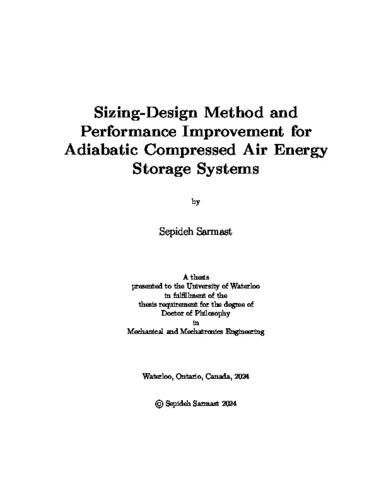| dc.description.abstract | Electrification of the energy system through renewable sources is an effective solution to combat the adverse effects of climate change. Despite the potential, integrating renewables into the electrical grid faces a significant challenge due to their intermittent nature. This intermittency impedes a seamless transition to sustainable, low-carbon electricity systems. In response, grid-scale electrical energy storage (EES) systems facilitate the storage of surplus electricity generated during low-demand periods for subsequent use during peaks. Among various storage methods, compressed air energy storage (CAES) has gained attention for its mechanical nature spanning over four decades. The recent emergence of Adiabatic CAES (A-CAES) facilities, such as the Goderich deployment, emphasizes the need for advancements. A-CAES systems aim to overcome challenges linked to thermal energy storage (TES), which constrains the round-trip efficiency of these systems (TES in A-CAES systems stores compressed air heat for efficient energy recovery).
The present thesis delves into the pursuit of engineering utility-scale A-CAES systems, with a specific focus on system sizing and design considerations. The primary research objectives include introducing a novel CAES sizing method, designing a near-adiabatic CAES system with appropriate thermal energy storage size and design to improve the system performance, and evaluating the compatibility of small-scale CAES systems with wind-diesel systems for remote Canadian communities.
While prior research has explored configurations of A-CAES and TES to enhance round-trip efficiency, certain critical aspects have been overlooked. Previous studies lacked focus on 1) external factors like power grid fluctuations, 2) operational limits in CAES system sizing and design, and 3) challenges in A-CAES operation (as predicted efficiencies often failed during experiments). This thesis aims to address the gaps in the existing literature by investigating the reasons behind these limitations. Potential contributing factors include reliance on generic thermodynamic models, lack of power grid connectivity, neglect of heat losses, and flaws in system designs. The aim is to comprehensively tackle these issues by proposing the sizing and design of a Near-Adiabatic CAES (NA-CAES) system. This approach seeks to rectify the shortcomings identified in previous models and enhance the overall understanding and performance of A-CAES systems.
The first objective, fulfilled in Chapter 3, introduces a new CAES sizing method, the coverage-percentage method. This method builds upon the frequency-of-occurrence method, integrating time-dependent operational constraints, component limitations, and pressure considerations within a CAES reservoir. Applying this method to Ontario's electrical grid data optimally sizes compressors, expanders, and cavern capacities, significantly enhancing the accuracy of capturing excess energy.
The second objective, addressed in Chapter 4, explores the operational limits of A-CAES system components, particularly turbomachines and TES systems. The chapter addresses disparities between theoretical models and practical experiments, employing sensitivity analyses to optimize operational modes. This optimization aims to enhance overall system efficiency while minimizing the required volume of TES. Chapter 4 concludes by determining charging, idle, and discharging profiles for the reservoir and TES of the NA-CAES system, tailored for Ontario, bridging the gap between theory and practical implementation. The results highlight the practicality of the NA-CAES system with a round-trip efficiency exceeding 60%.
In Chapter 5, the study expands its scope by exploring the integration of a partially A-CAES (PA-CAES) system with wind-diesel systems in remote areas. Building on findings from Chapters 3 and 4, the research assesses the performance of a small-scale CAES system, emphasizing sizing, design, operation, and viability in isolated regions. Unlike previous studies focusing solely on diesel engine efficiency, this research analyzes power supply-demand patterns and assesses the full-year performance and feasibility of deploying PA-CAES within wind-diesel hybrid systems using an optimization-based sizing method.
To sum up the research findings, a three-year analysis of Ontario's electrical grid data and an assessment of 82,500 scenarios provide insights for determining the optimal size of a CAES system. The coverage-percentage method highlights the importance of economic considerations to avoid oversizing components. The study identifies that compressors and expanders between 30 MW and 70 MW, cavern energy capacity of 630 MWh to 770 MWh, can capture at least 42% of charging and 26% of discharging capacity in Ontario. Results show that increasing compressor and expander sizes enhance coverage percentages up to an optimal point.
For a NA-CAES system, it is recommended to use a multi-tank TES to efficiently capture compression heat. The ideal number of TES tanks corresponds to the number of expansion units. The choice of thermal fluid does not affect the optimal temperature for TES tanks but depends on the expander inlet temperature. Achieving this optimal temperature involves optimizing mass flow rates for charging and discharging TES fluid and sizing TES tanks appropriately. A constant-pressure reservoir in a CAES system offers greater utilization and flexibility compared to a constant-volume reservoir, allowing longer and more efficient operation periods.
Additionally, investigating the feasibility of an adaptive energy storage system for a remote Canadian community shows potential to reduce diesel fuel dependence. A specific CAES configuration for a remote community, e.g., a 300 kW compressor, 200 kW expander, and 18,000 kWh reservoir, achieves a 55% reduction in diesel fuel consumption, presenting cost-effective solutions (an initial investment of $5,000,000). Another configuration with a 400 kW compressor, 290 kW expander, and 39,000 kWh reservoir achieves a higher reduction of 63.4%, albeit with a greater initial investment of $10,000,000. These findings contribute to optimizing CAES for both grid applications and sustainable energy solutions in remote areas. | en |

